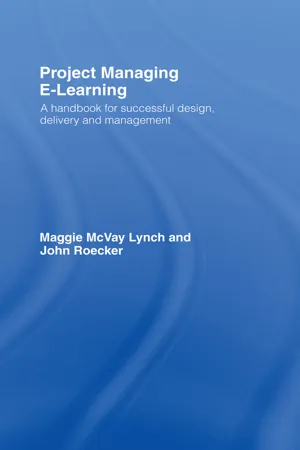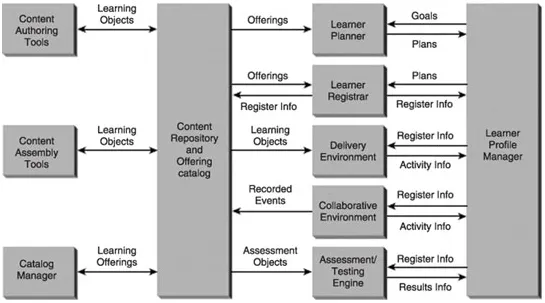![]()
Chapter 1
Definition and goals of the e-learning environment
What is e-learning?
E-learning is a term that is inextricably linked to the Internet. For more than 100 years educators have had many opportunities for providing learning at a distance. It began with itinerant teachers who would travel from town to town, then correspondence courses, and eventually video tapes and CDs or DVDs were sent by mail to the learner’s home. In the last 30 years synchronous training was made available through point-to-point video and eventually twoway interactive video courses. All of these have informed our practice of distance delivery and served as stepping stones to e-learning.
The primary precursor to the term e-learning was computer-based training. In fact, some would argue that because it was electronic it could be classified as e-learning. Computer-based training was set on a platform of linear instruction. Though some interaction was programmed into the course structure, the interaction moved you only in one direction. It wasn’t until the collaborative aspects of learning were included in an electronic medium that e-learning came into its own.
Most researchers would agree that the term e-learning refers to that part of distance learning relying on Web-based delivery systems. To add to that definition, we would suggest that e-learning also goes beyond the mere delivery of static content. Instead it includes collaboration, both synchronous and asynchronous, as well as some type of shared learning experience with fellow students.
One of the most comprehensive definitions of e-learning was offered by William Horton (2001): “E-learning is the use of Web and Internet technologies to create experiences that educate our fellow human beings.” To expand on this definition and provide details, we would add that e-learning is facilitated and supported through the use of information and communications technology, e-learning can cover a spectrum of activities from supported learning, to blended learning (the combination of traditional and e-learning practices), to learning that is entirely online. Whatever the technology, however, learning is the vital element. The wide adoption of the Internet and its social collaboration capabilities has helped e-learning to gain momentum as more people become learners and expect to use the facilities of the Web as an integral part of their learning process. Like the Web itself, the potential for e-learning seems to be growing and changing as new tools and processes become available.
Is there a specific pedagogical practice associated with e-learning?
Some would argue that the Web is primarily used as a means for wide distribution of content. Others would advocate for using the collaborative tools of the Web to enhance learning. We would suggest that pedagogy is determined by the instructional designer and/or instructor and related specifically to the topic needs and required outcomes. The use of a delivery mechanism, such as the Web, should not define a pedagogical practice. It should, instead, provide a mechanism for implementing the best pedagogy for that course or topic.
Whatever pedagogical philosophy you select, it is important to also remember that replicating something that exists within the traditional classroom is rarely the best solution for learners or teachers. Initial forays into e-learning tend to be pure content dissemination. The new e-learning developer looks at a class that was taught in lecture and then delivers that lecture over the Web, either by writing instructor notes and making them available or by physically taping the lecture and making it available. Though there may be good reason to do this in certain contexts, in most cases this is not a viable learning mechanism on its own. In fact, one might ask if the teaching strategy of a lecture in the classroom is delivering the best learning environment or just doing what has always been done. No matter what the reason for the classroom selection, on the Web the translation of that is even less effective because of the lack of physicality and certainly the lack of interaction.
It is because of this that e-learning journals, conferences, and practitioners have consistently advocated the increased use of collaborative learning tools and the decreased use of content dissemination in e-learning contexts.
What is project management?
Almost any human activity that involves carrying out a non-repetitive task can be a project. Building a backyard shed, planting a garden, planning a wedding, building a house, creating a new vehicle, launching a mission in space, building a skyscraper, creating a new drug, and developing a new computer application are all projects. So we are all project managers! We all practice project management (PM). But there is a big difference between carrying out a very simple project involving one or two people and one involving a complex mix of people, organizations, and tasks.
The art of planning for the future has always been a human trait. In essence a project can be captured on paper with a few simple elements: a start date, an end date, the tasks that have to be carried out and when they should be finished, and some idea of the resources (people, machines, etc.) that will be needed during the course of the project.
When the plan starts to involve different things happening at different times, some of which are dependent on each other, plus resources required at different times and in different quantities and perhaps working at different rates, the paper plan could start to cover a vast area and be unreadable.
Using ADDIE for design and project management
Good instructional design (ISD) and good project management is not the same thing. They may go hand in hand, but they are not interchangeable. Though we will use the familiar ADDIE model (Analyze, Design, Develop, Implement, and Evaluate) to help describe the instructional design tasks that might occur in each stage of e-learning project management, we also need to clearly state that ADDIE was never intended as a model for project management.
Figure 1.1 visually represents the ADDIE model and what occurs in each stage, as well as the relationship of the ADDIE stages to the phases of the IPECC project management model.
Figure 1.1 ADDIE model relationship to project management model.
The five stages of the ADDIE model are preceded by the initiating phase of our project management model. This initiating phase builds the business case for the project, determines the rough costs associated with undertaking the project and the expected organizational benefits resulting from it. This forms the overarching rationale for proceeding with the project. A project definition that outlines basic project parameters such as objectives, scope, milestones, and resource requirements is then drawn up by the project sponsor and the project manager to hand over to the project team.
Leading in to the five stages of the ADDIE model, the outputs and activities associated with each stage that need to be included in the project plan are as follows:
Analyze stage:
- Clarify organizational and training program objectives.
- Agree to the scope of the training program.
- Articulate training administration requirements.
- Determine strategies for transferring learned skills to the workplace.
- Detail project risks, opportunities, and assumptions.
- Investigate constraints in implementing the program, including technological, budget, timing, and duration.
- List training vendor/trainer selection criteria.
- Determine the target participants, program entry requirements, participant characteristics, and special needs.
- Determine extent of training participant knowledge/skill assessment required.
- Determine the tasks currently performed by target participants and level of performance required following the training.
- Estimate progra...


